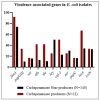Virulence-associated genes analysis of carbapenemase-producing Escherichia coli isolates
- PMID: 35536848
- PMCID: PMC9089865
- DOI: 10.1371/journal.pone.0266787
Virulence-associated genes analysis of carbapenemase-producing Escherichia coli isolates
Abstract
Carbapenem-resistant Escherichia coli has emerged as a major public health issue across the world. This study was aimed to determine the virulence content and phylogenetic groups of carbapenemase-producing E. coli isolates in southwest Iran. One hundred and fifty-two non-duplicate E. coli isolates were collected from various clinical samples. Antibiotic susceptibility and minimum inhibitory concentrations (MIC) were determined according to the Clinical and Laboratory Standards Institute (CLSI) guidelines by Kirby-Bauer disc diffusion and agar dilution methods. Phenotypic screening of carbapenemase enzymes was performed by modified Hodge test (MHT). Detection of carbapenemase genes, phylogenetic groups, and virulence-associated genes were also performed by the PCR assay. The highest and lowest resistance rates were observed against mezlocillin (70.4%) and doripenem (13.1%), respectively. Out of 28 isolates that were resistant to carbapenem antibiotics, 12 (7.9%) strains were phenotypically carbapenemase producers. The blaOXA-48 was the predominant carbapenemase gene, detected in 58.3% of isolates, followed by blaIMP (41.7%) and blaNDM (8.3%). None of the isolates harbored blaVIM and blaKPC genes. Among the twelve carbapenemase-producing strains, urinary isolates were mostly classified into B2 (41.7%) and D (25%) phylogenetic groups, while other clinical isolates belonged to B1 (25%) and A (8.3%) groups. The frequency of virulence-associated genes was also investigated in all isolates and ranged from 6.6% for hly to 75% for fimA. The emergence of carbapenemase-producing strains is a growing concern to public health. Therefore, the proper implementation of monitoring programs is crucial for limiting their dissemination.
Conflict of interest statement
The authors have declared that no competing interests exist.
Figures
Similar articles
-
Carbapenemase-Producing Carbapenem-Resistant Enterobacteriaceae from Bangkok, Thailand, and Their Detection by the Carba NP and Modified Carbapenem Inactivation Method Tests.Microb Drug Resist. 2018 Sep;24(7):1006-1011. doi: 10.1089/mdr.2018.0080. Epub 2018 May 21. Microb Drug Resist. 2018. PMID: 29782216
-
Phenotypic and genotypic detection of carbapenemase-producing Escherichia coli and Klebsiella pneumoniae in Accra, Ghana.PLoS One. 2022 Dec 30;17(12):e0279715. doi: 10.1371/journal.pone.0279715. eCollection 2022. PLoS One. 2022. PMID: 36584159 Free PMC article.
-
Virulence characterization and clonal analysis of uropathogenic Escherichia coli metallo-beta-lactamase-producing isolates.Ann Clin Microbiol Antimicrob. 2021 Aug 3;20(1):50. doi: 10.1186/s12941-021-00457-4. Ann Clin Microbiol Antimicrob. 2021. PMID: 34344363 Free PMC article.
-
[Investigation of carbapenemase genes and molecular epidemiology of Enterobacteriaceae strains isolated between 2010-2014 in a university hospitals].Mikrobiyol Bul. 2018 Jan;52(1):1-12. doi: 10.5578/mb.66156. Mikrobiyol Bul. 2018. PMID: 29642825 Turkish.
-
Prevalence of Extended-Spectrum Beta-Lactamase and Carbapenemase Genes in Clinical Isolates of Escherichia coli in Myanmar: Dominance of blaNDM-5 and Emergence of blaOXA-181.Microb Drug Resist. 2018 Nov;24(9):1333-1344. doi: 10.1089/mdr.2017.0387. Epub 2018 Mar 22. Microb Drug Resist. 2018. PMID: 29565227
Cited by
-
Prevalence of Plasmid-Mediated Fluoroquinolone Resistance Genes in Pseudomonas aeruginosa Among Patients at Aleppo University Hospital, Syria.J Clin Lab Anal. 2025 Feb;39(4):e25153. doi: 10.1002/jcla.25153. Epub 2025 Jan 21. J Clin Lab Anal. 2025. PMID: 39835407 Free PMC article.
-
Characteristics of ESBL-positive Klebsiella pneumoniae isolated from paired children with and without diarrhea.Gut Pathog. 2025 May 27;17(1):36. doi: 10.1186/s13099-025-00700-9. Gut Pathog. 2025. PMID: 40426260 Free PMC article.
-
"Molecular Characterization of Extended Spectrum Beta-Lactamase Resistance in Pediatric Shigella Isolates in Egypt".Biochem Genet. 2024 Nov 1. doi: 10.1007/s10528-024-10943-x. Online ahead of print. Biochem Genet. 2024. PMID: 39485669
-
Comparison of mortality rates in patients with carbapenem-resistant Enterobacterales bacteremia according to carbapenemase production: a multicenter propensity-score matched study.Sci Rep. 2024 Jan 5;14(1):597. doi: 10.1038/s41598-023-51118-9. Sci Rep. 2024. PMID: 38182719 Free PMC article.
-
Bacterial Superinfections After SARS-CoV-2 Pneumonia: Antimicrobial Resistance Patterns, Impact on Inflammatory Profiles, Severity Scores, and Clinical Outcomes.Diseases. 2025 May 9;13(5):145. doi: 10.3390/diseases13050145. Diseases. 2025. PMID: 40422577 Free PMC article.
References
-
- Enany ME, Algammal AM, Shagar GI, Hanora AM, Elfeil WK, Elshaffy NM. Molecular typing and evaluation of Sidr honey inhibitory effect on virulence genes of MRSA strains isolated from catfish in Egypt. Pak J Pharm Sci. 2018;31(5). . - PubMed
-
- Abolghait SK, Fathi AG, Youssef FM, Algammal AM. Methicillin-resistant Staphylococcus aureus (MRSA) isolated from chicken meat and giblets often produces staphylococcal enterotoxin B (SEB) in non-refrigerated raw chicken livers. Int J Food Microbiol. 2020;328:108669. doi: 10.1016/j.ijfoodmicro.2020.108669 - DOI - PubMed
MeSH terms
Substances
LinkOut - more resources
Full Text Sources




